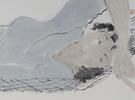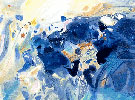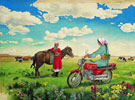Did you take the entrance examinations?
I decided not to quit my construction job after all. Half a month's salary was enough to buy the drawing tools and I had paintbrushes and paper given to me by my teacher, so I practiced sketching in my spare time on the job, and some other types of drawing at night. Once a week I would hand in a drawing assignment proposed by my teacher. The rest of the time I was busy catching up on a high school education. I sat for the art school exams after a year, and for three consecutive years after that, without any fear of failure. I had applied for the Yunnan Arts Institute, Sichuan Fine Arts Institute, Luxun Academy of Fine Arts, and so on, but my scores kept going down. The first time I sat the exams, I could not even remember the 26 letters of the alphabet and I only got an 8 in English. The second time, I found an English teacher, but my final score was only 3. Furious, I decided to give up the examinations, quit my job and raise long-haired rabbits to pay for my drawing classes. But I was not familiar with scientific breeding methods and the rabbits all died. Luckily I would find my way. My grandmother would often say, “Every creature finds its way to happiness in the end. It is just a matter of time.”
Did you try again?
No. I had what could be called lucky break. In 1985, I came upon a job advertisement from the local cultural centre seeking applicants with a senior high education who could sing, dance and play the piano. I passed the exam and was recruited as an art director. Suddenly, I had plenty of time to practice drawing. The work in the cultural centre was monotonous; I only had to design several editions of blackboard content and organize one or two art workshops per year. (It was from these classes that I received the title “Teacher Luo”). Interestingly, it was after I had earned a small reputation in local art circles that I found out that the classmate who had claimed to have studied at the Yunnan Arts Institute was in fact a con artist: he would wander the streets with a palette on his back pretending to be an art student just to impress the ladies. He was not an artist at all, but he managed to get me hooked on art forever. I should invite him out for a drink sometime to thank him for lying to me!
Did you enjoy the job?
At first, I was filled with a sense of accomplishment, but for a person who had enjoyed his freedom and often absented himself from work, showing up at work every day proved to be a challenge. Behind the porcelain factory had been a field and a river where I could go swimming and fishing, all I had to do was climb over the wall; now faced with the walls of the cultural centre every day, I felt anxious, like something was missing. The cultural centre operated a simple outdoor kiln to fire bricks, and sure enough, after a few of years I had made enough clay and pottery works to fill up every square inch of my office.
When did you realize that sculpture was your passion?
One day in mid-1987, our director (a friend) showed me a small newspaper ad for a one-year sculpture research class organized by Mr. Qian Shao, former director of the Department of Sculpture the Central Academy of Fine Arts. The director encouraged me to apply, arguing that it would be worth traveling to Beijing to learn sculpture from Mr. Qian. It meant the world to me. In the past, “climbing over the wall” had been my own idea, but this time, it was the director and the town officials who pushed me to step up. My friends said, “We've pushed you over the wall. How far you go from here is up to you.”
I joined the class. Mr. Qian was a great teacher in that he never told the students what to do or how to do it in minute detail. It was his style to throw out simple remarks that were actually valuable comments. Although he was already 80 years old, his thoughts and views were very avant-garde for the time. Under his guidance, I began to realize what art really was. During my studies in Beijing, I had a chance to get to know more about Western art, and I developed a preference for French sculpture, particularly for the works of Maillol and Moore.
Was that a turning point for you?
After returning to Mi’le in 1989, I launched myself into frantic sculpture production. I selected clay and wood as my main materials and focused on the life of the ethnic groups; their singing and dancing were the main themes for my freestyle, casual kneading. In 1990, I organized my first solo exhibition at the Yunnan Arts Gallery, running up a debt of 3,000 yuan. The only mark of success of the show came in the form of a hand-penned inscription by Mr. Qian, who dubbed it “A heavenly delight.”
Where did your inspiration come from?
It is hard to tell where my inspiration came from, just as it is hard to explain why a tree bears fruit overnight. Every work of mine was an understanding, an experience or a reflection of things past, or the embodiment of some premonition of things to come.
Why did you move to Kunming?
In Mile, the river passing in front of the door of my childhood home disappeared, along with the playing dragons, taking all my sweet memories of childhood along with them. The debt I had incurred while organizing my 1990 solo exhibition would have taken five years to pay off with my salary from the cultural centre. Staying would have been like a death penalty. “Out of the 36 schemes, the best is one is getting away at once.” The provincial capital was a place where one could make money; even selling buns on the street could turn a profit. That was my main reason for leaving: my priority was not art, but survival and making money.
In the 1940s and 50s Kunming had been known as a city of waterways seated on the high plateau. Boats constituted the main mode of transportation and the city was interspersed with docks. People were not rich, but it was a peaceful city whose inhabitants lived in tune with the sky, earth and water. Nowadays, Kunming people are avidly looking toward to the future.
From 1985 to 1992, I invested more in my art than I could afford with my salary. Since there were no art foundations in China, I had to figure out how to support my artistic endeavors myself. After much effort I had gotten a job in the cultural field, but after a brief period of satisfaction, it felt like a cage. This bird needed to be outside. No matter how high or how far I was going to go, I could not get anywhere unless I got out. As a result, I resigned from my position in August 1992 and left the gilded cage empty handed.
I founded the Dada Art Company in Mi’le to fill out official sculpture commissions. It was easy enough to make money, but that is an unforgiving pitfall any artist must face at some time or another. At the end of 1993, I incorporated the company in Kunming with myself as the main shareholder. In their optimism, the other shareholders made the mistake of appointing me as chairman of the board. With someone who was forgetful by nature, devoid of any sense of numbers and who did not follow the rules at the helm, the result was predictable: the company went bankrupt within six months. The company collapsed before it was able to produce a single work. I sat down and began to take stock of the complexities involved in doing business.










